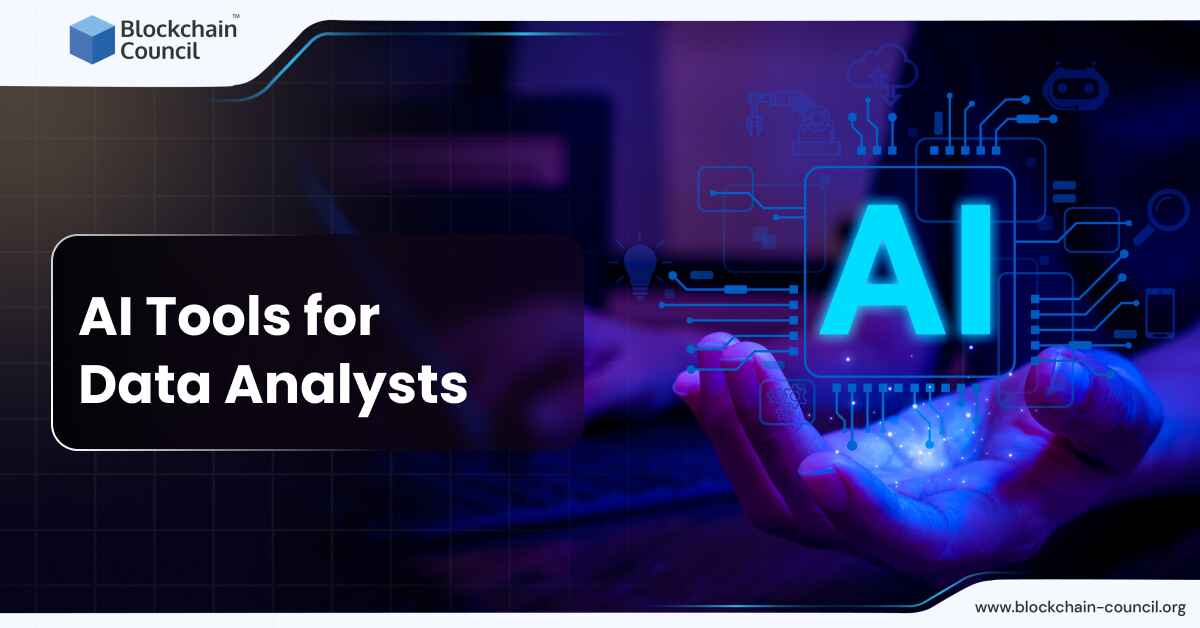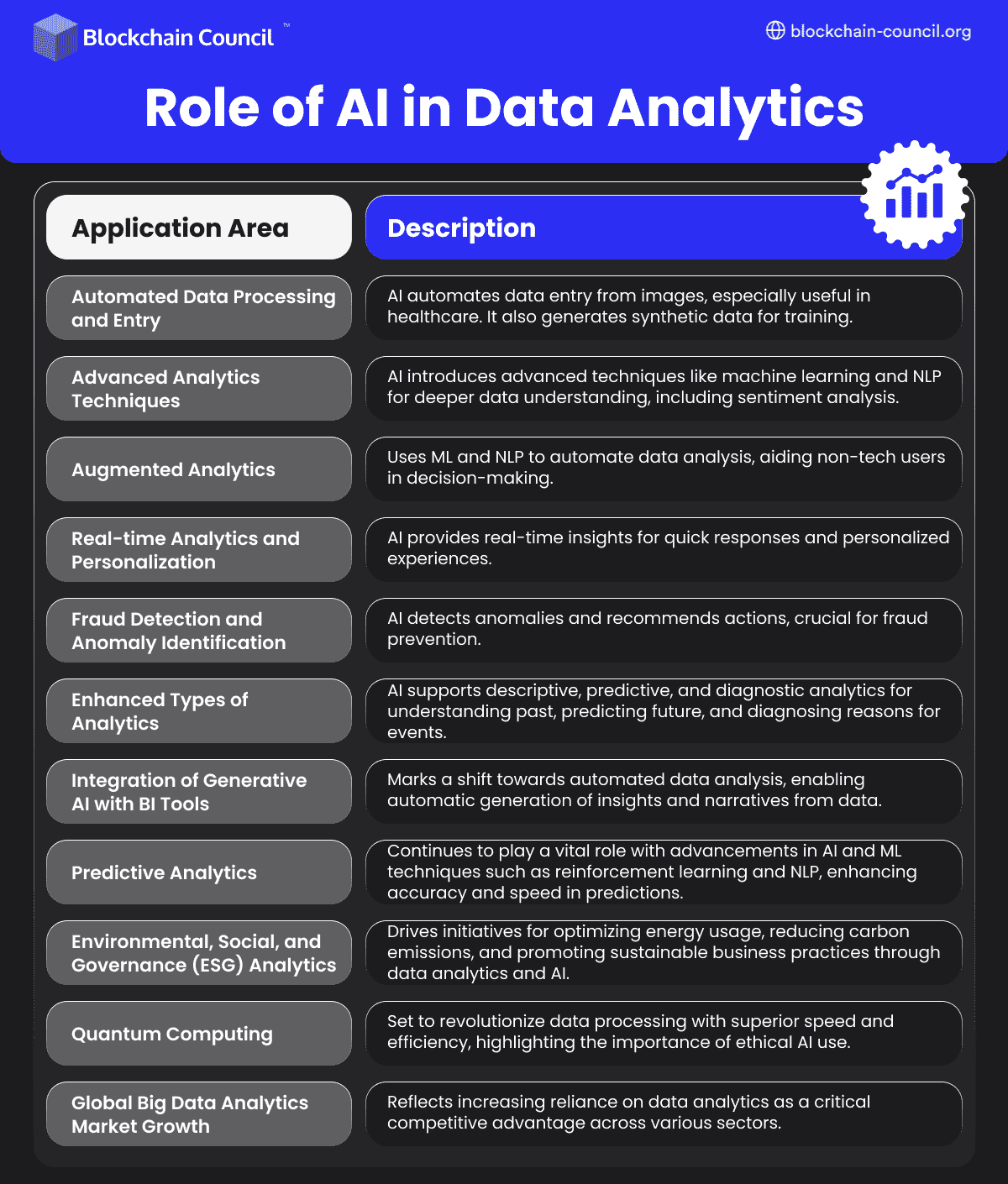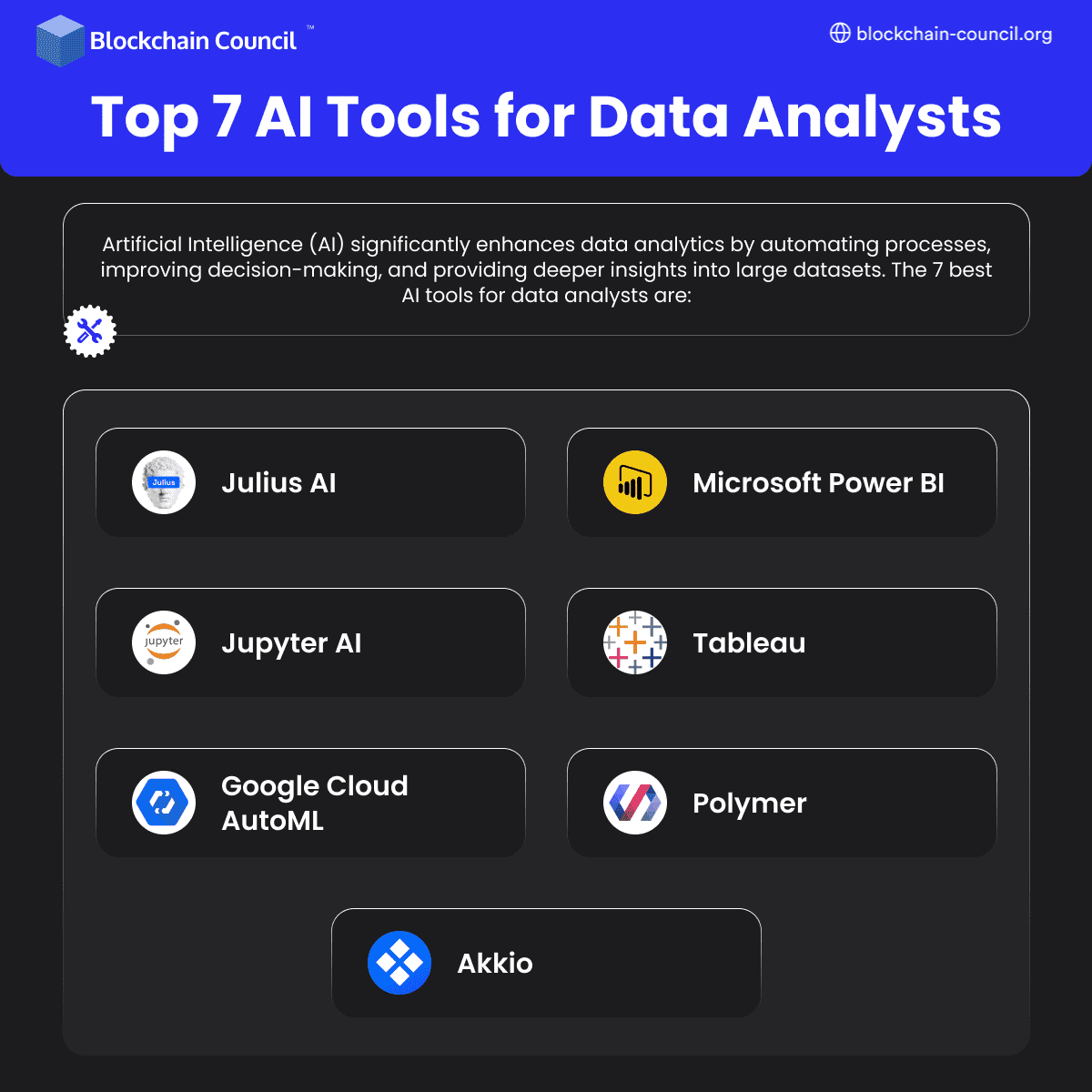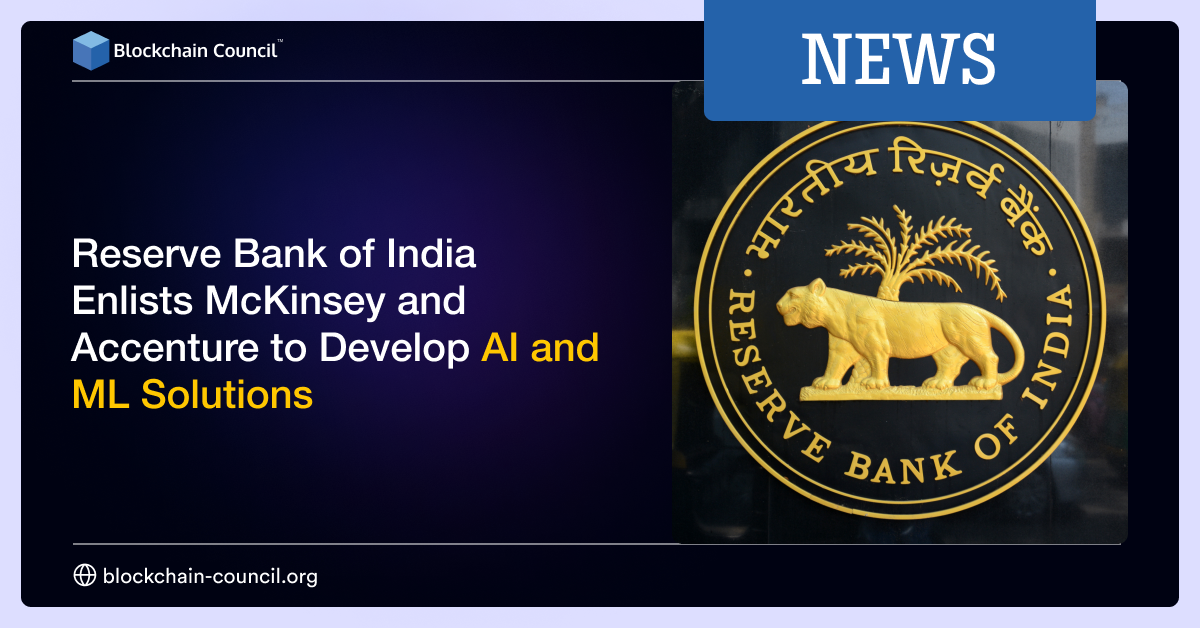
- Blockchain Council
- September 02, 2024
Summary
- AI tools have become essential for data analysts, enabling the transformation of large datasets into actionable insights swiftly and accurately.
- These tools leverage advanced technologies like machine learning and natural language processing to automate tasks, identify patterns, and forecast trends.
- AI’s role in data analytics includes automated data processing, advanced analytics techniques, real-time analytics, and fraud detection, among others.
- Key trends in 2024 show AI reshaping data analytics approaches, driving efficiency, and fostering innovation across industries.
- The top 7 AI tools for data analysts include Julius AI, Microsoft Power BI, Jupyter AI, Tableau, Google Cloud AutoML, Polymer, and Akkio.
- Each tool offers unique features, pros, and cons, catering to different analytical needs and skill levels.
- Selecting the right AI tool involves identifying needs, considering ease of use, integration capabilities, open-source vs. proprietary options, specific features, and pricing.
- The future of AI in data analytics is promising, with advancements expected in synthetic data generation, automated dashboards, NLP, data security, and more.
- AI tools like Julius AI, Microsoft Power BI, and Polymer lead the way, empowering analysts to navigate large datasets effectively and uncover valuable insights.
- As AI tools evolve, they are expected to become more user-friendly, democratizing data insights and facilitating informed decision-making across various sectors.
In the fast-paced world of data analytics, the integration of Artificial Intelligence (AI) has become not just a luxury but a necessity for those aiming to stay at the forefront of the industry. AI tools are pivotal in transforming massive datasets into actionable insights with unprecedented speed and precision. This article discusses the top 7 advanced AI tools that have become indispensable for data analysts. Such AI tools focus to enhance data analysts’ capabilities to process, analyze, and visualize data in ways that were once thought to be beyond reach.
These tools, leveraging cutting-edge technologies like machine learning, predictive analytics, and natural language processing, enable analysts to unlock new levels of efficiency and insight. From automating routine data processing tasks to identifying complex patterns and forecasting future trends, AI tools empower analysts to deliver more value from their data. This exploration includes a detailed look at the leading AI tools for data analysts in 2024, their unique features, their challenges, and how they cater to various analytical needs across different industries.
Role of AI in Data Analytics
The role of Artificial Intelligence (AI) in data analytics is evolving rapidly, becoming an indispensable tool for businesses seeking to derive actionable insights from their data. This evolution is highlighted by several key trends in 2024, which are reshaping how organizations approach data analytics and management, driving efficiency, and fostering innovation.
Here are some key roles of AI in data analytics:
Top 7 AI Tools for Data Analysts
Artificial Intelligence (AI) significantly enhances data analytics by automating processes, improving decision-making, and providing deeper insights into large datasets. The 7 best AI tools for data analysts are:
Julius AI Overview
Julius AI is an AI-powered data analysis tool that simplifies the process of analyzing and visualizing data. It’s designed to work with spreadsheets, Google Sheets, and Postgres databases, providing advanced features for tasks such as modeling, projections, and linear regression. Users can interact with Julius AI through a natural language processing interface, asking it for insights into their data.
Pros:
- Enables easy analysis and visualization of data with a ChatGPT-style conversational interface.
- Offers automation of data preparation and the ability to create statistical models without advanced technical knowledge.
- Supports the creation of data animations and allows for easy export and sharing of insights.
- Available on iOS and Android devices, with excellent support through a chatbot, email, and a Discord community.
Cons:
- Limited real-time support for users.
- Lack of an Application Programming Interface (API) for developers.
- Fewer third-party plugins available for integration.
Also Read: What is Microsoft Copilot?
Microsoft Power BI Overview
Microsoft Power BI is a suite of business analytics tools designed to help individuals and organizations efficiently consolidate, analyze, and visualize data from a wide variety of sources. These include on-premises databases, Excel spreadsheets, and cloud-based repositories. It consists of several components: Power BI Desktop (a desktop application), the Power BI service (an online SaaS), and Power BI Mobile apps for iOS, Android, and Windows devices. Together, these tools enable users to create sharable reports and dashboards that provide insights into business data.
Pros:
- Offers a comprehensive platform for data integration, analysis, and reporting, with support for numerous data sources.
- It easily integrates with Microsoft’s ecosystem, like Dynamics 365 and Microsoft Purview, enhancing business apps and governance.
- Facilitates the creation of rich, interactive reports and dashboards that can be accessed from anywhere, enhancing decision-making across organizations.
- Provides advanced data analytics capabilities, including AI insights, to uncover patterns and trends within data sets.
Cons:
- Some advanced features and greater analytics capabilities require a subscription, potentially increasing costs for organizations or individuals needing these functionalities.
- The platform’s wide range of functionalities and options might present a steep learning curve for users new to business intelligence tools.
Jupyter AI Overview
Jupyter AI is a recent addition to the Jupyter ecosystem, focusing on integrating generative AI into Jupyter notebooks. This open-source project emphasizes responsible AI and data privacy, allowing users to choose the Large Language Model (LLM) and embedding model that best fits their needs. The project is notable for its adherence to the core principles of Project Jupyter, including simplicity, usability, modularity, extensibility, and a focus on ethical considerations and social responsibility. Users can engage with Jupyter AI through a chat interface within notebooks, enabling interaction with various LLMs for tasks like code generation, error fixing, and content summarization. Installation is straightforward via pip, and Jupyter AI supports a range of model providers while also planning for local model support to enhance privacy further.
Pros:
- Integrates powerful generative AI capabilities directly into Jupyter notebooks, enhancing productivity and creative potential.
- Promotes responsible AI use and data privacy, giving users control over their interaction with AI models and data transmission.
- Supports a wide range of generative model providers, making it versatile for different needs and preferences.
- Offers both a conversational chat UI for assistance with coding tasks and %%ai magic commands for direct command execution within notebooks.
Cons:
- As with any AI tool, there’s a learning curve for new users to get familiar with the commands and functionalities offered by Jupyter AI.
- Dependence on third-party LLM providers might introduce concerns regarding data privacy and model availability, although Jupyter AI emphasizes user consent and privacy.
- Currently, it’s in the early stages of development, which means users might encounter bugs or limited features until the project matures.
Also Read: How to Learn AI with GitHub Copilot?
Tableau Overview
Tableau is recognized for its innovative approach to data analytics, offering a comprehensive suite of AI-plus-analytics capabilities. It’s designed to make data analysis and insight consumption accessible across an organization, allowing for data-driven decisions. Its AI functionalities, powered by generative AI, enable the platform to understand patterns, learn from data, and generate new insights, making complex data analysis tasks more manageable for users of all skill levels. Tableau Pulse, a key feature, delivers personalized, smart, and contextual insights to users, streamlining their workflow and decision-making processes.
Pros:
- Accelerators expedite dashboard creation and connection to popular data sources.
- User-friendly interface on both desktop and mobile platforms.
- Extensive integration with other tools like Python, R, and Einstein Discovery, enhancing its analytics capabilities.
- Incorporates AI to simplify analytics, making it easier for users to obtain insights.
Cons:
- Users have reported inconsistent performance and occasional crashes, particularly on Android devices.
- Some complex queries can lead to longer load times than desired.
- The broad range of features might be overwhelming for beginners.
- Dependency on internet connectivity for Tableau Cloud, which could be a limitation in areas with poor internet service.
Google Cloud AutoML
Google Cloud AutoML is a suite of machine learning tools that enables both developers and data scientists to build and deploy custom ML models efficiently. It simplifies the machine learning process by automating tasks like data preprocessing, feature engineering, and model selection. AutoML is designed for organizations aiming for rapid model deployment without extensive ML knowledge. It includes a graphical user interface for custom model building and API integration for application embedding. AutoML is beneficial for quick experimentation and identifying the best ML models for specific needs.
Pros:
- Simplifies machine learning processes with automation, making advanced modeling accessible to non-experts.
- Offers a wide range of pre-trained models for various applications, reducing the need for in-depth machine learning knowledge.
- Supports integration with Google Cloud services, providing scalability and flexibility for deploying models.
Cons:
- Might require some understanding of machine learning concepts to optimize the use of AutoML tools effectively.
- The cost can escalate with extensive usage, especially when processing large datasets or deploying complex models.
- Limited control over the model’s internal workings, which might not suit all business or research needs.
Polymer Overview
Polymer is a Business Intelligence (BI) tool designed to simplify data visualization and dashboard creation, making it accessible to users without requiring extensive technical skills or complex setups. It’s marketed as BI “without the BS,” focusing on ease of use and rapid insight generation. Polymer provides a variety of data connectors, allowing users to quickly upload datasets or connect to platforms like Shopify, Stripe, and Google Ads. The platform employs AI to analyze data and suggest insights, automating the creation of rich, insightful dashboards. It offers features like real-time data access, intuitive drag-and-drop dashboard builders, and a wide array of visualization widgets including column & bar charts, time series, heatmaps, and more, all designed to make data exploration and presentation straightforward and efficient.
Pros:
- Offers an intuitive interface and AI-powered suggestions for visualizations, lowering the barrier to entry for effective data analysis.
- Users can quickly connect data sources and generate dashboards without the need for coding, making it suitable for non-technical users.
- Supports a wide range of visualization types, from basic charts to more complex formats like scatter plots and bubble charts, catering to various data presentation needs.
Cons:
- While the AI-generated insights and visualizations facilitate ease of use, they may limit customization options for users wanting more control over their data analysis.
- Advanced data analysts or businesses with highly specific BI requirements might find the tool’s focus on simplicity and automation a limitation.
- After the initial free trial period, continued access to Polymer’s full features comes at a cost, which could be a consideration for individuals or smaller organizations looking for free tools.
Also Read: Guide to Learning AI with Microsoft Copilot
Akkio Overview
Akkio is a cutting-edge AI platform tailored for analytics and predictive modeling, making it a potent tool for analysts seeking to enhance their data analysis capabilities. Founded in 2019 and based in Cambridge, MA, Akkio focuses on providing a generative AI platform that simplifies the creation of predictive models, helping businesses to generate new revenue, add value to their clients, and improve overall productivity. The platform streamlines the machine learning process with features like Chat Explore™ for data exploration, forecasting tools, generative reports, and Chat Data Prep™ for data preparation. Akkio’s cloud-based solution is designed to assist in tasks ranging from forecasting and lead scoring to text classification, making it easier for businesses to bring ML-enabled workflows to life.
Pros:
- Akkio’s intuitive platform simplifies data preparation and exploration, making machine learning accessible to a broader audience.
- The platform supports various business operations, including marketing, by providing predictive analytics that can inform smarter decision-making.
- Being cloud-based, Akkio offers flexibility and scalability for businesses looking to leverage AI and machine learning without significant infrastructure investment.
Cons:
- While Akkio offers a range of pricing plans, starting from $49 per month for the Starter plan, the cost may be a consideration for smaller businesses or individual analysts.
- Despite its ease of use, there’s still a learning curve involved in mastering the platform to fully leverage its capabilities for predictive modeling and analytics.
How to Select the Right AI Tool for Data Analytics:
- Identify Your Needs: Determine whether you need the tool for text analysis, data visualization, machine learning model building, or a combination of these.
- Ease of Use: For those not deeply familiar with data analytics, tools like Julius AI offer a user-friendly interface for analyzing data through natural language prompting, making it accessible to a wider range of users.
- Integration Capabilities: Consider tools like Microsoft Power BI and Excel, which integrate well with existing Microsoft products and offer AI-powered features like natural language queries and automated insights.
- Open-Source vs. Proprietary: Decide if an open-source tool like Jupyter AI, which offers a conversational assistant for Python coding tasks, fits your project better than proprietary software with specific pricing plans.
- Specific Features Needed: Look for tools with unique features that match your specific project requirements, such as Polymer for easy data visualization or MonkeyLearn for AI-powered text and data analysis without coding.
- Pricing: Ensure the tool’s pricing aligns with your budget. Many tools offer a free trial or a free version with limited features, with the option to upgrade to more comprehensive plans.
Future of AI in Data Analytics
| Technology Area | Role of AI |
| Synthetic Data Generation | Expected to grow, aiding in diversifying datasets for training AI models |
| Automated Dashboards/Reports | Simplifying creation, making data visualization accessible, even to novices |
| Automated Data Entry | Saving time and improving efficiency through AI-driven conversion of image data to digital formats |
| Increased Use of NLP | Making data analytics more accessible by enabling natural language queries and report generation |
| Enhanced Data Security | Identifying and protecting against security threats in growing data volumes |
Conclusion
The landscape of AI tools for data analysts in 2024 is both rich and dynamic. The future of AI in data analytics is shaping up to be increasingly integral, with AI tools becoming more sophisticated and accessible. These tools not only automate mundane tasks, saving time for data professionals, but also open up new possibilities for predictive analytics, decision making, and uncovering insights that were previously difficult to access due to the complexity of big data. Most AI models are expected to be trained on synthetic data by 2030.
With tools like Julius AI, Microsoft Power BI, Polymer, and others leading the charge, analysts are equipped with the resources needed to navigate the complexities of large datasets effectively.
Through a curated exploration of the latest and most effective AI tools available, this piece aimed to guide data analysts to use AI for maximal impact. As these tools continue to evolve, we can expect them to become even more user-friendly, making data analytics accessible to a broader range of professionals and business users. The integration of AI in data analytics is likely to further democratize data insights, enabling more informed decision-making across various sectors of the economy.
Frequently Asked Questions
What are AI tools for data analysis?
- AI tools for data analysis are software applications that use artificial intelligence techniques such as machine learning, natural language processing, and predictive analytics to process, analyze, and visualize large datasets.
- These tools automate tasks like data entry, pattern recognition, and trend forecasting, enabling data analysts to derive actionable insights more efficiently.
- Examples of AI tools for data analysis include Julius AI, Microsoft Power BI, Tableau, Google Cloud AutoML, and Jupyter AI.
How do AI tools benefit data analysts?
- AI tools streamline data analysis processes by automating repetitive tasks, saving time and effort for data analysts.
- They provide deeper insights into large datasets by identifying complex patterns and correlations that may not be immediately apparent to human analysts.
- AI tools enhance decision-making by generating predictive models and recommending actions based on data analysis results.
What are the key considerations when selecting an AI tool for data analysis?
- Identify specific analytical needs, such as data visualization, predictive modeling, or natural language processing.
- Consider ease of use, integration capabilities with existing tools and systems, and the learning curve for mastering the tool.
- Evaluate pricing plans and scalability options to ensure the chosen AI tool aligns with budget and future growth requirements.
What are some examples of AI tools for data analysts?
- Julius AI: Offers conversational interface for data analysis and visualization, simplifying tasks like modeling and linear regression.
- Microsoft Power BI: A comprehensive platform for data integration, analysis, and reporting, with support for various data sources and AI-powered features.
- Google Cloud AutoML: Enables building and deploying custom machine learning models efficiently, simplifying tasks like data preprocessing and model selection.
What is the future of AI in data analysis?
- The future of AI in data analysis is expected to focus on further automation of tasks, including synthetic data generation and automated report generation.
- AI algorithms will become more sophisticated, enabling deeper analysis of unstructured data types like text and images.
- Ethical considerations, such as data privacy and bias mitigation, will become increasingly important as AI tools play a larger role in decision-making processes.







































































 Guides
Guides News
News Blockchain
Blockchain Cryptocurrency
& Digital Assets
Cryptocurrency
& Digital Assets Web3
Web3 Metaverse & NFTs
Metaverse & NFTs
